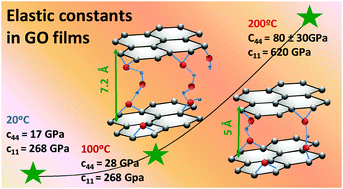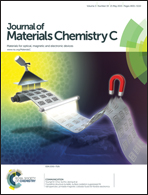Elastic constants of graphene oxide few-layer films: correlations with interlayer stacking and bonding†
Abstract
We propose a strategy to study the elastic properties of extremely thin graphene oxide (GO) films using Brillouin spectroscopy. The dependence of the surface acoustic wave of a gold capping layer on the structural, chemical and morphological changes occurring to the underneath GO film with temperature is reported and analyzed. At room temperature the shear constant c44 is ∼17 GPa and hardens up to 28 GPa at 100 °C due to the partial elimination of embedded water layers and to interlayer distance shrinking. At 200 °C the almost complete elimination of water induces layer stacking disorder, further GO–GO distance reduction and a significant increase of all elastic constants. The in-plane constants harden due to the partial restoration of the sp2 C network (c11: from 268 to 620 GPa) and the out of plane constants harden due to the H bonds that now directly connect the neighbouring GO layers (c44 ≈ 80 GPa). The obtained Young's moduli are significantly higher than those reported for GO paper because the ultra-thin GO films are highly ordered and there is no macroscopic applied strain during the measurement. The results obtained here are associated with the intrinsic properties of GO as in-plane and inter-layer bonding.


 Please wait while we load your content...
Please wait while we load your content...